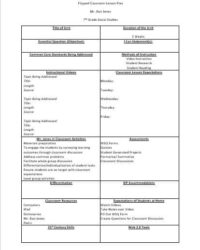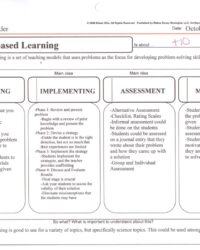Flipped learning has revolutionized educational approaches, transforming the traditional classroom into a dynamic, student-centered environment. It is more than just watching videos at home; it is a pedagogical strategy that maximizes in-class time for active learning by shifting direct instruction to an out-of-class setting. This innovative model empowers students to take ownership of their learning, fostering deeper understanding and critical thinking skills. For educators, however, implementing this shift effectively requires meticulous planning and a clear roadmap, which is precisely where a well-designed flipped learning lesson plan template becomes indispensable.
Moving beyond rote memorization, flipped classrooms prioritize application, discussion, and collaborative problem-solving during precious face-to-face time. This pedagogical pivot demands a structured approach to ensure that the pre-class, in-class, and post-class components seamlessly integrate, creating a cohesive and impactful learning experience. Without a robust framework to guide the process, educators might find themselves overwhelmed, and students might miss the full benefits of this transformative model. A thoughtfully constructed template acts as your guide, ensuring every facet of the flipped lesson is considered and optimized.
Unpacking the Essentials of a Flipped Classroom Lesson Plan
A comprehensive flipped classroom lesson plan is fundamentally different from a traditional one. It is not just about what happens during class, but critically, what happens before and after. The plan must detail the pre-learning activities students engage with independently, often digital content like videos or readings. This preparation is the bedrock, allowing in-class time to be dedicated to higher-order thinking, application, and personalized support. It shifts the burden of initial information delivery from the classroom to the student’s own flexible schedule, making in-class time more efficient and interactive. Think of it as preparing the ground before planting the seeds for growth.
The “before” class component is perhaps the most crucial difference. Here, the flipped learning lesson plan template outlines the specific content students are expected to engage with. This might include curated videos, online articles, podcasts, or even specific textbook readings. Clear objectives for this pre-learning phase are vital, ensuring students know exactly what they need to grasp before stepping into the classroom. It is not merely assigning homework; it is purposeful direct instruction delivered asynchronously, designed to build foundational knowledge. Educators must consider the length, complexity, and accessibility of these materials to ensure all students can engage effectively.
Pre-Class Preparation and Student Autonomy
- Content Selection and Curation: Choose or create engaging materials that effectively deliver core concepts.
- Clear Learning Objectives: Communicate what students should know or be able to do after completing the pre-class work.
- Accessibility and Engagement: Ensure materials are easy to access and designed to maintain student interest and comprehension.
During class, the plan transforms into a guide for active learning. Instead of lecturing, the teacher facilitates, guides, and intervenes. This is where students apply the knowledge gained from pre-class activities through discussions, group projects, problem-solving exercises, or hands-on labs. The flipped lesson plan must meticulously detail these in-class activities, ensuring they are designed to deepen understanding, address misconceptions, and foster collaborative learning. This phase truly leverages the teacher’s presence, allowing for immediate feedback and targeted support. It transforms the classroom into a dynamic workshop where learning is actively constructed.
In-Class Engagement Strategies
- Problem-Solving Activities: Design tasks that require application of pre-learned concepts.
- Collaborative Group Work: Encourage peer-to-peer learning and discussion.
- Teacher as Facilitator: Outline strategies for guiding students and providing individualized assistance.
Finally, the “after” class component closes the loop, offering opportunities for consolidation and assessment. This might involve reflective journals, follow-up assignments, or formative assessments to gauge understanding and identify areas needing further reinforcement. A comprehensive flipped learning lesson plan template should account for these post-class activities, ensuring continuous learning and providing valuable data for the teacher to inform future instruction. It is about solidifying new knowledge and ensuring it sticks.
Crafting Your Own Flipped Learning Lesson Plan Template
Creating your own flipped learning lesson plan template does not have to be an overwhelming task. Start by identifying the core elements essential for every lesson: learning objectives, pre-class activities, in-class activities, and assessment. Think about the flow of information and student engagement across these phases. What information do you consistently need to jot down? What prompts or sections would help you ensure you are not missing any critical steps in the flipped model? Customizing a template to fit your specific teaching style, subject matter, and student needs will make it an invaluable tool for efficiency and effectiveness.
A well-structured template provides consistency, saves time, and ensures that the pedagogical goals of flipped learning are consistently met. Instead of starting from scratch for each unit, you will have a ready framework that guides your planning process. This allows you to focus more on the content and less on the administrative task of organizing your thoughts. It acts as a mental checklist, prompting you to consider student preparation, the nature of in-class collaboration, and how you will measure learning outcomes efficiently.
The beauty of a template lies in its adaptability. While it provides a structured framework, it also allows for flexibility. You can add sections for differentiation, technology integration notes, or even space for reflecting on lesson success. The goal is to create a living document that evolves with your teaching practice, making the planning of flipped lessons intuitive and comprehensive.
- Define Learning Objectives for Each Phase: Clearly state what students should achieve pre-class, in-class, and post-class.
- Allocate Time for Pre-Class, In-Class, and Post-Class Activities: Plan realistic timeframes for each segment.
- Integrate Assessment Methods Consistently: Decide how you will check understanding at various stages.
- Plan for Differentiation and Support: Include sections for accommodating diverse learner needs.
- Note Required Resources: List all materials, technologies, and spaces needed.
Embracing a systematic approach to flipped learning through a well-designed lesson plan is a powerful step towards maximizing student engagement and deepening their understanding. It transforms the planning process from a daunting task into a strategic exercise, ensuring every component of the flipped model works in harmony to support learning objectives.
By leveraging a tailored template, educators can confidently navigate the nuances of flipped instruction, creating vibrant and effective learning environments where students thrive. This proactive planning not only benefits the students by providing a clear learning path but also empowers the teacher to become a more effective facilitator of knowledge and skill development, leading to richer educational experiences for everyone involved.


